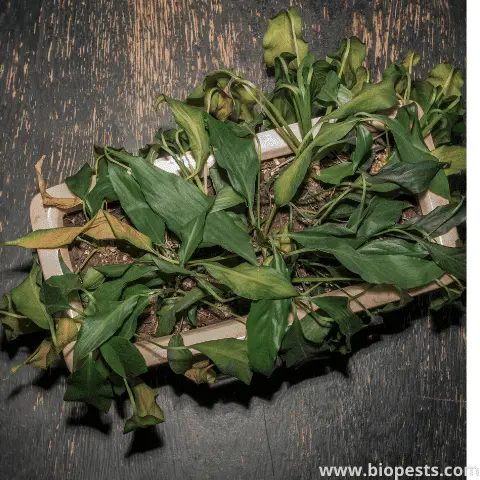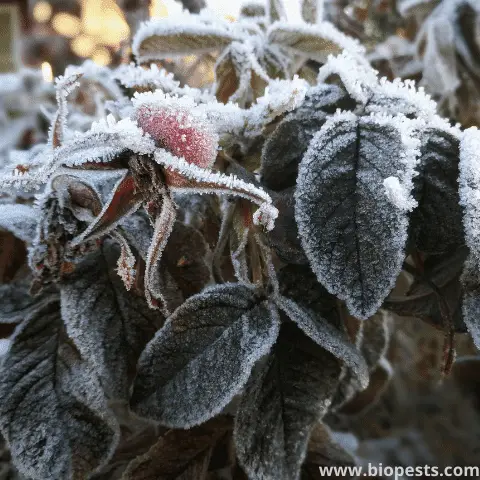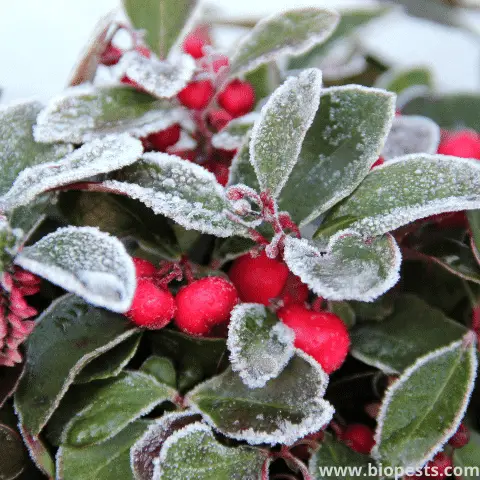Having a full garden and lots of plants is always a beautiful thing to take pride in, however as the cold months roll nearer, your plants are subject to damage. As someone with lots of plants, I find it essential to learn to care for them in any situation that may arise. Thus, how do you help houseplants recover from cold shock?
Gently watering and slowly warming a cold-shocked plant will slowly bring it from its shocked state, easing it from a frosty coma. This rehydrates and protects the plant from any more frost. The recovery process should be slow and steady to avoid shocking the plant further.
You may feel compelled to do a few things to help your plant, like putting it in a heated area and fertilizing it; however, this will only shock and damage the plant further. As frustrating as it may seem, bringing a plant back from cold shock is a delicate and slow process. While the damage to affected areas is permanent, plants are resilient and will grow new foliage as they recover.
How To Help Houseplants Recover From Cold Shock
Like humans, plants are at risk of damage and even death due to excessively cold conditions and temperatures. The cold damages their growth and prohibits the proper functioning needed for their survival – this is called cold shock.
Cold shock widely affects outdoor plants during winter months in areas that experience temperature drops down to 32° F / 0° C or lower. However, if the indoor environment is cold enough, houseplants are just as vulnerable to suffering at the hands of cold weather.
What Is Cold Shock?
When temperatures drop to freezing levels, frost forms from water vapor that condenses and freezes, the cold winds and weather then hit the plants, freezing the water inside the leaves. This promotes cell damage – and cell death – which, in turn, damages the plant and can lead to its death.
Cold shock poses a threat to many living things not adapted for extreme cold weather and conditions; however, plants are at a disadvantage as they cannot move to warmer areas or protect themselves against the threats cold weather brings. Thus, putting preventative measures in place before the winter months is the best way to protect your plants, but it is also possible to help plants already damaged by the cold.
Houseplants And Cold Shock
In comparison to outdoor plants, indoor plants are at an environmental advantage when recovering from cold shock. Granted, it seems unlikely that indoor plants would get cold shock in the first place considering that they are in a warmer, sheltered environment; however, most houseplants are tropical. Thus, they are susceptible to temperatures under 50° F / 10° C, which are temperatures a lot of colder regions could easily achieve and get even colder.
A deciding factor in the plants’ chance of survival is how long they are exposed to cold temperatures. Some may start dying as soon as the temperature dips, but generally, tropical plants die after 12 – 24 hours of exposure to cold temperatures.

If you’re unsure about the state of a plant’s health, checking the plant for symptoms of cold shock, especially checking the roots, will alert you of its health. If the root ball is firm and maintains its shape, it is healthy enough to survive. However, if the root ball is loose or mushy, the plant will die. If the roots are somewhere in between, you can help the plant recover with the following methods.
Symptoms Of Cold Shocked Plants
The symptoms of cold shock in plants aren’t hard to spot. Whether you were late to take your houseplants and tropical plants inside, or you’re wondering what happened to your garden, knowing the symptoms will help you minimize your losses and nurture your plants back to health.
- Wilting or Drooping – Leaves and stems will curl or droop due to cell damage that hinders their rigidity.
- Discoloration – White, yellow or red marks on the leaves are spots of dead cells killed by frost. In some cases, not all the cells will immediately be affected. The damaged leaves will eventually die and fall off.
- Softened or Blackened Foliage – Another sign of cell death is when the plant becomes soft and turns black in some areas. This discoloration is similar to what happens when a person gets hypothermia.
- Loose Root Balls – Gently feel the root ball by moving the plant to see how loose it has become. A very loose root ball that moves quickly, it probably suffered severe damage, and the entire plant may be in danger.
Another symptom would be the woody stems or trunks splitting. Some of the symptoms you see or don’t see may differ depending on the plant, but most signs – such as wilting, discoloration, and the condition of the root balls – are universal and easy to spot when you take a closer look.
How To Recover Plants From Cold Shock
The steps you need to take to recover your plants from cold shock may seem ineffective and even too minute to make a difference, but if you observe and track your plant progress, you should notice the affected plants recovering slowly over time.
- Watering – Although it may not seem like much, the best course of action is to water your cold shocked plants gently. Pouring the water over the plant and on the soil will help it recover from any trauma and stress. When plants experience a freeze, they lose moisture, so giving them about an inch of water helps them rehydrate. The water will also warm it slightly and combat frost.
- Moving – Moving your plants away from where they got damaged, or huddling them close together in a group, could prevent further shock. If you move it, ensure the temperature change from their previous to new placement is not too drastic; otherwise, going from the cold to warmth – or even being in sudden, direct sunlight – will shock and damage the plant further. It is best to ease them into any changes. You can also group plants close together, allowing them to have collective warmth and protection.
It may be tempting to take fast and drastic measures to remove your plant from the danger of more damage and to help them recover quickly from the damage already done. Even though it may seem like the best thing to do, these kinds of actions are likely to cause more harm than good.
- Pruning – While you may want to prune away the dead parts of a plant, it is better to leave those sections as extra layers of protection from the cold for the rest of the plant. Wait until the weather warms (or a month for indoor plants) before cutting off any affected areas which haven’t fallen on their own.
- Fertilizing – Promoting new growth through something like fertilizing will put more stress on an already weakened plant. Yes, fertilizer will give the plant a nutrient boost, but its energy must be focused on recovery rather than new growth before it is ready. Once the plant has recovered, it will begin to sprout new growth.
Spotting symptoms of cold shock is the first step to helping your plants recover. This requires observation and investigation of the plants and their overall condition after an unexpected cold snap that you could not prepare them for. Upon discovering signs of cold shock, the severity needs to be assessed to determine whether the plant has a chance of survival. Usually, if the majority of a plant and its interiors are softened and blackened, it is unlikely that they will recover. Though, spotting new growth on the plant suggests the opposite.

Throughout the recovery process, the plant’s state will have to be carefully and continuously monitored to identify if any damage is worsening. Bear in mind, affected areas will be permanently damaged and will either fall off or need to be cut off at the appropriate time. However, the damage should be contained and prevented from spreading further through the plant as you carry out recovery and preventative measures.
Although it may be appealing to promote new growth as soon as possible, this would only divide the plant’s strength and attention. The plant must focus its energy on recovering from the stress and trauma caused by any cold and frosty weather rather than promoting new growth, which would make it more susceptible to further damage.
It could take weeks, if not months, for a full recovery and new, healthy growth in the plant. With a combination of care and patience, it is entirely possible to see a full recovery in the affected plants.
Cold Shock Prevention
It’s always best to take preventative measures and avoid the problem as a whole. Whether your plants are susceptible to cold shock or you want to avoid cold shock damage in the future, there are several things you can do.
- Appropriate Covers – Covering plants – even just at night – will protect them from the worst of the cold winds and frosts.
- Thorough Irrigation – It may seem far-fetched, but irrigation that thoroughly applies water to plants means there will be more ice. For water to turn into ice, it must expel heat (latent heat of fusion); this heat protects the plants from damage.
- Insulation – Keeping warm soil during brief cold snaps protects some plants enough to continue their health. Other plants may wilt and die if roots get too warm, so insulation for pots can help maintain cooler soil and protect against freezing.
- Move the Plants – Moving your plants indoors or in a warmer, protected space will shield them from the harsh effects of the colder weather. Even if the days are relatively warm, moving the plants inside at night will protect them from the colder midnight temperatures.
- Anti-transpirant Sprays – These sprays shield your plants from moisture loss. Once the spray dries, it becomes a transparent and flexible protective coating and doesn’t interfere with plant growth, osmosis, or photosynthesis.
- Supplemental Heating – Having a heated area is a sure way to regulate temperature and protect your plants from colder conditions.
- Cold Frames – These are bottomless boxes are set over plants in the garden to protect them from adverse weather.
Using these methods – or a combination of them – does not guarantee that your plants will be free of cold damage, but they do limit the extent of cold shock, minimizing the severity.
However, if the damage is already done, it does not mean death for your plant. Following the recovery measures discussed above, there is a chance to save your plant and nurse it back to health. Additionally, you can install some preventative measures – such as covering it or using anti-transpirant sprays – to protect your plant from further damage as it begins to recover.
Extra Vulnerable Plants
Cold shock for any plant can be traumatic; however, some plants are at higher risk than others. Tropical plants, succulents, and cacti are all at higher risk than your ordinary plants.
Being desert plants, succulents and cacti retain and store more water in their stems and bodies than regular plants. This makes them more susceptible to serious cellular damage when experiencing a freeze. Thankfully, most of these plants are resourceful, so this damage is not a death sentence.
To know whether or not the plant will survive, you should assess it for damage. If the foliage is discolored and damaged, the damage in those areas will be permanent, but this does not mean that the rest of the plant will die along with those areas. You should monitor its condition and help the plant recover by doing your part. If the plant’s interiors are soft or black, they are unlikely to survive. However, if you spot new growth, it is a sign that they can pull through.
Additionally, tropical plants are exceptionally vulnerable to chilly winds, frosts, and freezes. Their low tolerance to the cold means they may experience extra stress during the winter months. They can be treated like any other plant with cold shock damage, though it is always best to prevent any damage from taking place at all.
Conclusion
Helping your houseplants – and any other plants – recover from cold shock is an entirely achievable feat as long as you take the proper steps. Closely monitoring the plant’s condition as you rehydrate and protect the plant from further damage is the most you can hope to do.
It would be best to avoid shocking and stressing the plant further, allowing it to focus its energy on recovering from the trauma caused by the harsh weather. While it may seem like you are not doing enough through just watering and maybe moving the plant, it is the best course of action. It is up to the plant itself to heal, recover and eventually return to its previous condition.
Spotting new growth on your plant is a positive sign for its overall health and ability to recover.

